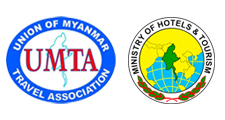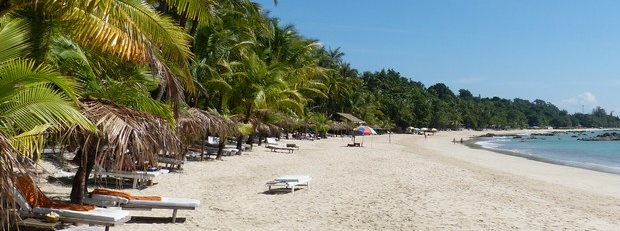
Shwe Myanmar & Turquoise Sea
This 12-day beautiful Golden Land tour will take you to Bagan, Popa, Mandalay, and Inle Lake from Yangon extended to Ngapali Beach of Turquoise Sea.
Day 1-Yangon airport - the guide will welcome you and check in at your hotel.
Day 2-Proceed to start your sightseeing with Botahtaung Pagoda. After lunch, start your visit to Bogyoke (Scott) Market which has the largest selection of Burmese handicrafts. Then, enjoy visit at Shwedagon Pagoda, the 'heart' of Buddhists in Myanmar.
Day 3-Fly to Nyaung U and visit Bagan. Temple sightseeing and sunset boat trip to be enjoyed.
Day 4-Drive to Popa Taungkalat, home to Myanmar's intriguing 37 'nats' and major pilgrimage destination. Enjoy your visit to a very nice Popa Mountain Resort with fabulous view. Then drive back to Bagan.
Day 5-Fly to Mandalay and start your sightseeing with Amarapura and visit U-Bein Bridge. Then visit Mahagandayon Monastery, known as the biggest Buddhist learning Centre in Mandalay to learn the daily life of monks. Continue to Mahamuni Pagoda.
In the afternoon, visit Shwenandaw Monastery (Golden Palace Monastery) as a museum, an ancient wooden monastery. Then visit to Kuthodaw Pagoda (also known as the Maha Lawka Marazein Pagoda), the pagoda complex has been dubbed 'the world's biggest book'. Enjoy Sunset at Mandalay Hill.
Day 6-Start your trip to Mingun Bell, Mingun Pagoda, and Hsinbyume Pagoda (Also known as Myatheindan Pagoda). In the afternoon, transfer to jetty and take the local ferry to visit Innwa (Ava) and sightseeing around Ava by horse-cart. Continue to Sagaing to enjoy sunset at Sagaing Hill and the hill itself has a number or stupas and monasteries.
Day 7-Fly to Heho and proceed to Inle Lake. Visit the famous Phaung Daw Oo Pagoda and Nga Phe Kyaung (Cat jumping) Monastery, one of the oldest monasteries on the lake to see ancient Buddha images.
Day 8-Second day on the Lake. Today, explore one of the local 5-day markets, as easily called, are well-known visit around the lake. Then proceed to the Indein pagoda complex - an archaeological site where hundreds of Shan-style pagoda ruins are situated on a sloping hill, some entirely hidden by vigorous bush and foliage.
Day 9-Fly to Ngapali Beach. Situated in the Rakkine state, it still retains some of its regional culture and fishing village roots, with small boats out on the seas day and night bringing in fresh seafood to supply the many beach side restaurants here. Silken white sands, clear blue waters and some unbeaten seafood options, make this place a little strip of heaven.
Day 10- Leisure at the beach. Snorkeling trips by boat can be arranged and a great way to observe the beautiful tropical fish in the pristine waters.
Day 11-Fly back to Yangon.
Day 12-Depart.
~ All sightseeing tour and transfer services with private air conditioned car as per our itinerary
~ Accommodation with breakfast at hotels as specified
~ Meals where specified
~ Domestic flight tickets with available domestic airlines in Myanmar
~ Transfers and tours with the same language speaking local guide throughout
~ All entrance fees for the places as mentioned in the program
~ Boat trip as specified in our itinerary
~ Train ticket as specified
~ Trekking
~ Insurance surcharge on Domestic Airlines in Myanmar
~ Domestic airports taxes
~ Service charges, room tax and baggage handling
~ Water and snow towel during sightseeingExcluded in our price:
~ Services not mentioned in our itinerary
~ Meals where not specified
~ Visa fees
~ International flight tickets to and from Yangon
~ International airport departure tax of US$ 10.00 per person (Currently)
~ Expenditure of a personal nature (Such as: uses of mini-bar and refrigerator, laundry service, telephone call and etc...)
~ Travel insurance (cover against all cancellation costs, medical expenses, including repatriation, in the event of accident or illness)The price for the above arrangements will be from USD2200 per person based on 2 people sharing a twin / double room and excluding international air travelling.
*Please note that the price confirmed at the time of booking is subject to change and depends on the availability of accommodation.
East Hotel
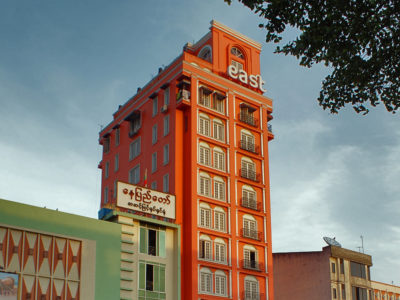 East hotel is a boutique hotel, set in the heart of the Yangon business district and is conveniently located between two major roads, Sule Pagoda and Bogyoke. The property is unique in that when many hotel a large proportion of similarly designed rooms with a small amount of individual rooms, east is the other way around. East hotel radiate an opulent charm of contemporary Myanmar décor perfectly blended with the traditional warmth of Myanmar hospitality.
East hotel is a boutique hotel, set in the heart of the Yangon business district and is conveniently located between two major roads, Sule Pagoda and Bogyoke. The property is unique in that when many hotel a large proportion of similarly designed rooms with a small amount of individual rooms, east is the other way around. East hotel radiate an opulent charm of contemporary Myanmar décor perfectly blended with the traditional warmth of Myanmar hospitality.Zfreeti Hotel
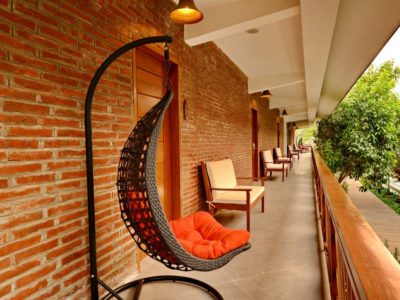 Last decade ago, the area of Zfreeti Hotel was standing as two separate hotels named ‘New Heaven’ and ‘Golden Village’ Hotel. In 2012, those old styled bungalows were demolished and the contemporary two storied buildings were developed which is mixed with ancient Bagan architectural design. The location of the hotel is situated in a very prime area of Nyaung U. Bagan’s main food corridors for tourists are in a walking distance from the hotel.
Last decade ago, the area of Zfreeti Hotel was standing as two separate hotels named ‘New Heaven’ and ‘Golden Village’ Hotel. In 2012, those old styled bungalows were demolished and the contemporary two storied buildings were developed which is mixed with ancient Bagan architectural design. The location of the hotel is situated in a very prime area of Nyaung U. Bagan’s main food corridors for tourists are in a walking distance from the hotel.Hotel Yadanarbon
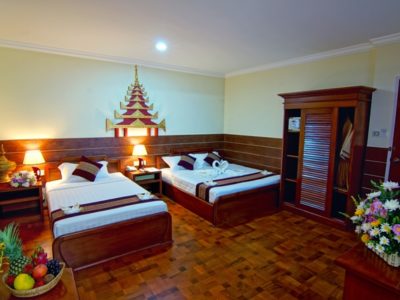
Hotel Yadanarbon is situated in the heart of Mandalay City (near Mandalay Railway Station, Yadanarbon Super Market, Diamond Plaza Shopping Malls and Mandalay General Hospital). It is 5 minute drive to Zegyo Market and Night Bazaar and 10 minute drive to major tourist attraction places.
Paradise Inle Resort
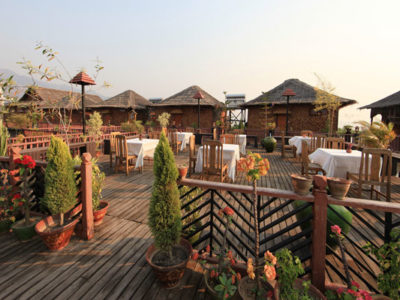 Paradise Inle Resort located in the midst of splendour of serene Inle Lake, the resort offers an ideal leisure and relaxation experience and had been meticulously restored to its original amenities of Inle region. Wooden walkways connect all bungalows with the main reception building, restaurant and jetty. The resort is entirely made out of local materials and designed with a comfortable sitting area, a private terrace with an incredible view.
Paradise Inle Resort located in the midst of splendour of serene Inle Lake, the resort offers an ideal leisure and relaxation experience and had been meticulously restored to its original amenities of Inle region. Wooden walkways connect all bungalows with the main reception building, restaurant and jetty. The resort is entirely made out of local materials and designed with a comfortable sitting area, a private terrace with an incredible view.
Pleasant View Resort
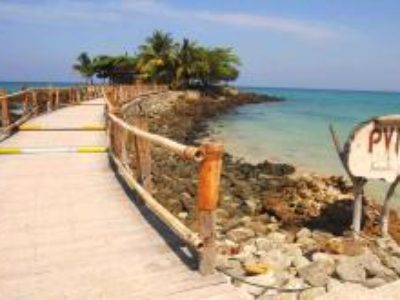 Nestled between the Rakhine Yoma Hills and the Bay of Bengal, the Pleasant View Resort offers you a place of luxurious comfort, with spectacular views of Ngapali Beach and breath-taking sunsets. Within this exclusive enclave, guests can select from their 56 Deluxe Rooms, each featuring their own spacious comfort & charm, catering to the unique needs of holidaying families, friends hanging out together, or couples in romance.
Nestled between the Rakhine Yoma Hills and the Bay of Bengal, the Pleasant View Resort offers you a place of luxurious comfort, with spectacular views of Ngapali Beach and breath-taking sunsets. Within this exclusive enclave, guests can select from their 56 Deluxe Rooms, each featuring their own spacious comfort & charm, catering to the unique needs of holidaying families, friends hanging out together, or couples in romance.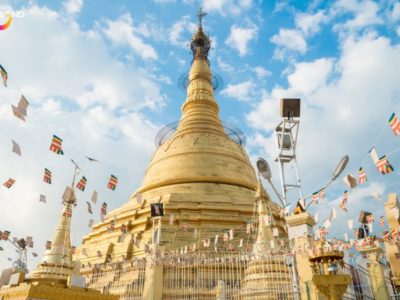 Botahtaung Pagoda is close to the Yangon Jetty (Botahtaung Jetty). Bo means leader and Tahtaung means one thousand in Burmese. Botahtaung means One Thousand Military Leaders/Officers of the king. They were drawn up as a guard of honor to welcome the landing in Burma of the relics of the Buddha brought over from India more than two thousand years ago. There is a sort of mirrored maze inside the stupa, with glass showcases containing many of the ancient relics.
Botahtaung Pagoda is close to the Yangon Jetty (Botahtaung Jetty). Bo means leader and Tahtaung means one thousand in Burmese. Botahtaung means One Thousand Military Leaders/Officers of the king. They were drawn up as a guard of honor to welcome the landing in Burma of the relics of the Buddha brought over from India more than two thousand years ago. There is a sort of mirrored maze inside the stupa, with glass showcases containing many of the ancient relics.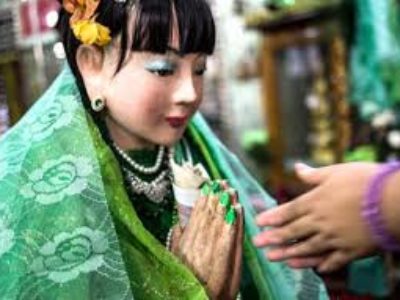 Botahtaung pagoda is also a home to a nat, or spirit, shrine of Amadaw Mya Nan Nwe, a devout Buddhist famous for her devotion to the pagoda, dedicated her life to making merit. Following her death in 1957, Amadaw Mya Nan Nwe became a revered figure in her own right. In 1990, a shrine containing a statue of her was erected inside Botataung Pagoda, and from that point on she was worshipped as Mya Nan Nwe Htayyi (Goddess), a nat with the power to grant the wishes of those who appealed to her for help.
Botahtaung pagoda is also a home to a nat, or spirit, shrine of Amadaw Mya Nan Nwe, a devout Buddhist famous for her devotion to the pagoda, dedicated her life to making merit. Following her death in 1957, Amadaw Mya Nan Nwe became a revered figure in her own right. In 1990, a shrine containing a statue of her was erected inside Botataung Pagoda, and from that point on she was worshipped as Mya Nan Nwe Htayyi (Goddess), a nat with the power to grant the wishes of those who appealed to her for help.Bo Bo Gyi means great grandfather, traditionally refers to the name of a guardian spirit, nat, unique to each Burmese Buddhist temple or pagoda. Bo Bo Gyi is typically depicted as a nearly life-sized elderly man, dressed in a curved cap and sometimes carrying a cane, to signify old age. Offerings of scarves and paso are common by worshipers. There are many Bo Bo Gyi shrines throughout the country, and some are more widely respected than others. Botahtaung Bo Bo Gyi is more famous among the Thai tourists who repeatedly visit the Bo Bo Gyi shrine yearly as their wishes are said to be fulfilled. They would like their forehead to be touched by Bo Bo Gyi’s pointed figure and make a wish.
Bogyoke (Scott) Market (closed on every Mondays & Public Holidays) has the largest selection of Burmese handicrafts, antique, jewellery, clothing and arts. The market is a major tourist destination and known for its colonial architecture and inner cobblestone streets.
Shwedagon Pagoda is the 'heart' of Buddhists in Myanmar. The Pagoda is believed to be 2,600 years old and there are always full with many people praying and making offerings at Shwedagon and especially on Full Moon days and religious days.
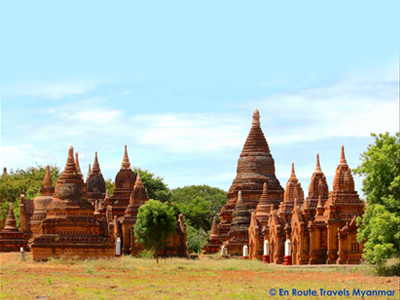
Bagan, situated in central Myanmar is one of the world’s richest archaeological and historical sites, featuring more than 2,000 pagodas and temples all set on a vast 26 square-mile plain beside the legendary Ayeyarwady River. The Bagan kingdom was swept away by earthquakes and the invasion by Mongols. Some 2,230 of an original 4,450 temples survive. Buddhist belief that to build a temple was to earn merit and that could be the reason there were so many pagodas throughout Bagan’s desert plain.
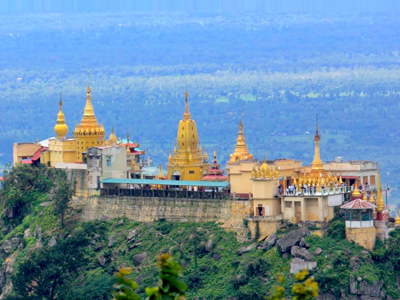
Popa : In the middle of the scorched plain 50 kilometres (30miles) from Bagan rises Mount Popa, an extinct volcano set in a national reserve whose slopes are covered in lush greenery. Beautiful as it is, the primary draw is a smaller rocky outcrop rising steeply out of its slopes atop which perches Popa Taungkalat monastery known as the “Olympus of the Nats” as it is home to Myanmar's legendary 37 "Nats" (animist spirits).
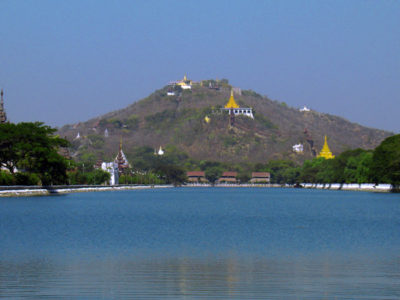 Mandalay: Preceded by associations of a rich and exotic past, Mandalay’s name resonates well beyond the borders of the country. The last royal capital of Burma and the country’s second largest city, Mandalay is considered the main economic hub of Upper Burma and is rich in Burmese culture, arts, artisans and architecture, as well as a cultural and religious centre for Buddhism in the country. Mandalay’s positioning also means it’s a great base for sightseeing trips to other ancient royal capitals.
Mandalay: Preceded by associations of a rich and exotic past, Mandalay’s name resonates well beyond the borders of the country. The last royal capital of Burma and the country’s second largest city, Mandalay is considered the main economic hub of Upper Burma and is rich in Burmese culture, arts, artisans and architecture, as well as a cultural and religious centre for Buddhism in the country. Mandalay’s positioning also means it’s a great base for sightseeing trips to other ancient royal capitals.Amarapura: Once a city of some 170,000 inhabitants, Amarapura (‘City of Immortals’), is now just a quiet southern suburb of Mandalay. The town is well known for its numerous workshops where bronze foundries and woodcarvers creating devotional objects for the markets of Mandalay, and the looms of cotton and silk weavers produce fine longyis. Nearby U Bein Bridge, the longest teak bridge in the world is perhaps the most unique attraction. The bridge, constructed using 1700 vast teak pillars, stretches 1.2 kilometre over fertile fields and is still, over two centuries after it was built, an integral part of the community with hundreds of locals and monks making their way back and forth across it daily. The bridge is particularly popular at sunset as it provides a famous photo opportunity as the sun sinks behind the chunky pillars of the bridge.
Mingun: With a short and scenic trip up the Ayeyarwaddy from Mandalay you find Mingun, best known for the Mingun Pahtodawgyi, a huge, unfinished pagoda, which, if completed, would have stood at over 150 metres and been the largest monument in the world. At 50 metres high, what remains of the pagoda is still spectacular, and climbing up its ruin’s barefoot rewards explorers with a fantastic view of the Ayeyarwady. Mingun is also home to the world’s largest working bell. Weighing 90 tons, the Mingun Bell is actually second in size to one in the Kremlin in Moscow but the Russian bell is cracked and therefore not in service. A trip from Mandalay takes around one hour upriver and 40 minutes to return, a perfect way to spend a morning or afternoon.
Innwa: With a few interruptions Innwa (formerly known as Ava) was the capital of the Myanmar Kingdom for nearly 400 years, making it the longest running centre of government in the nation’s history. The city was finally abandoned in 1839 after a series of devastating earthquakes and the majority of intact buildings were transferred first to Amarapura and then to Mandalay. What remains is the exquisite Bargaya Monastery, famous for its 267 teak posts, the largest of which is 9 feet in circumference, and covered in elaborate wood carvings and embellishments. The Nan Myint watchtower, which stands slightly tilted, is also popular as an interesting example of Myanmar architectural style in the early 19th century.
Sagaing: Once the capital of Shan Kingdom in the 14th century, is a peaceful religious centre of Buddhism and a popular place for meditation. Sagaing Hill, crested with pagodas rises out of the western bank of the Ayeyarwaddy River and is a fabulous vantage point to gaze across the more than 500 pagodas, temples and monasteries that litter the landscape and are home to more than 600 monks and nuns.
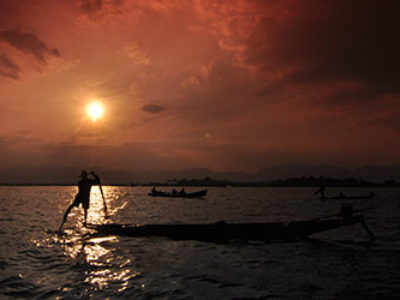 Inle Lake: Set in the heart of the vast Shan State and ringed by hazy mountain ranges, the shallow waters of Inle Lake are one of Myanmar’s most stunning scenic and cultural attractions. Its position 900 metres above sea level rewards visitors with pleasant temperatures throughout the day and can call for a jumper in the evening. The hills surrounding the lake are a melting pot of culture and are inhabited by over 30 ethnic groups. Of these, the Inthar, are perhaps the best known.
Inle Lake: Set in the heart of the vast Shan State and ringed by hazy mountain ranges, the shallow waters of Inle Lake are one of Myanmar’s most stunning scenic and cultural attractions. Its position 900 metres above sea level rewards visitors with pleasant temperatures throughout the day and can call for a jumper in the evening. The hills surrounding the lake are a melting pot of culture and are inhabited by over 30 ethnic groups. Of these, the Inthar, are perhaps the best known. 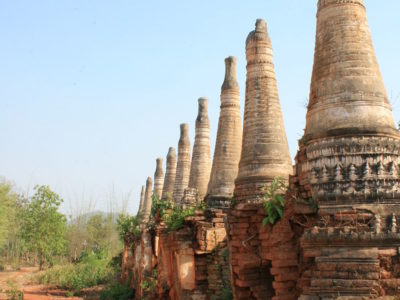
Indein is one of the small villages of Inlay Lake located on the western bank of the lake. A Buddha Image has been enshrined at a whitewashed stupa, which is on the summit of a hill. Below the stupa around the hill are cluster of hundreds of ancient stupas. The walkway of Shwe Indein Pagoda is one of the longest. The walkway itself is the market area lined with endless souvenir stalls.
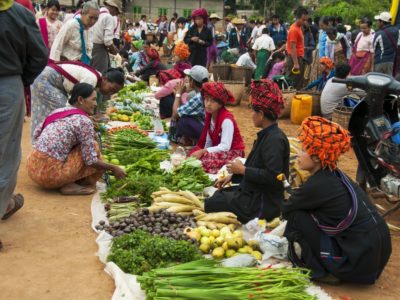
The 5-day Markets rotate among the villages in regular order - one village becomes the host of the market every 5th day. Exploring these markets will highlight the insight into the daily life of the ethnic Pa-O, Danu and Inthar inhabitants, who come to these markets to sell their local produce and goods. The ways of life and traditional dresses of the different tribes are such a sight to behold.
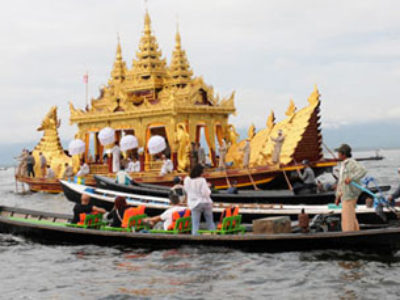 Phaung Daw Oo Pagoda Festival - Every year, on the eve of the full moon day in October, the Phaung Daw Oo Pagoda festival is held, which sees the pagoda's revered Buddha images displayed on the golden Karaweik – a replica of the ancient royal barge – and taken to villages around the lake. Unlike most other pagoda festivals in Myanmar, which typically run for about three days, the Phaung Daw Oo Pagoda festival goes for 18 days, and also includes boat races that attract spectators near and far.
Phaung Daw Oo Pagoda Festival - Every year, on the eve of the full moon day in October, the Phaung Daw Oo Pagoda festival is held, which sees the pagoda's revered Buddha images displayed on the golden Karaweik – a replica of the ancient royal barge – and taken to villages around the lake. Unlike most other pagoda festivals in Myanmar, which typically run for about three days, the Phaung Daw Oo Pagoda festival goes for 18 days, and also includes boat races that attract spectators near and far. Ngapali Beach: is the go to destination for travelers craving sun, sea and sand in Myanmar, with some saying it is the most beautiful beach in the whole country. Situated in the Rakkine state, it still retains some of its regional culture and fishing village roots, with small boats out on the seas day and night bringing in fresh seafood to supply the many beach side restaurants here.
Silken white sands, clear blue waters and some unbeaten seafood options, make this place a little strip of heaven. With the sand ways on the beach being smoother than the infamously bumpy roads of the area, many locals prefer to use the beach front to pull their ox and cart, making for a unique sight to behold and a reminder of you where you are in the world.
Some fantastic luxurious resorts can be found at Ngapali Beach, the best in the country, but thankfully not too many as to crowd the beautiful shoreline. Snorkelling trips by boat can be arranged by most hotels, a great way to observe the beautiful tropical fish in the pristine waters. This beach is stunning spot for a relaxing end to a rigorous sightseeing tour of the country, or even a purely direct option for those wanting an unadulterated beach holiday with a splash of unique culture.
-
Contact Us
No. 489/B, 3rd Floor, 11th Street,
11th Quarter, South Okkalapa Township,
Yangon, Myanmar.
Tel : +959 424 611 168, +959 750 126 164
Email : info@enroutetravelmyanmar.com
Email : sales@enroutetravelmyanmar.com
Web : www.enroutetravelmyanmar.com









